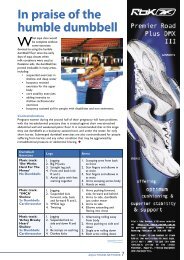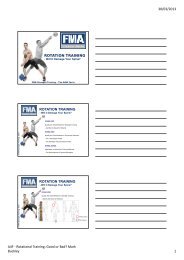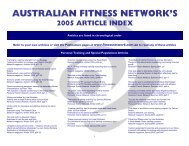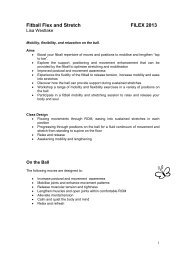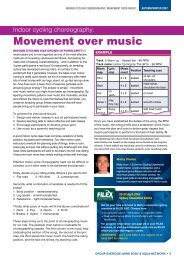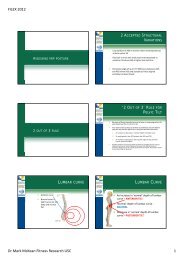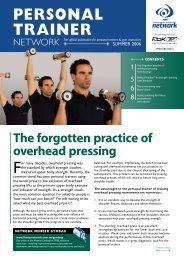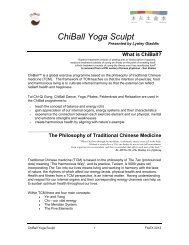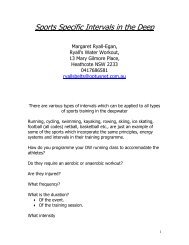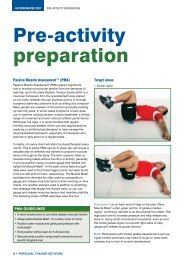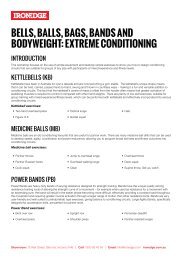CD - Australian Fitness Network
CD - Australian Fitness Network
CD - Australian Fitness Network
Create successful ePaper yourself
Turn your PDF publications into a flip-book with our unique Google optimized e-Paper software.
AUTHOR’S BIO<br />
REGULAR FEATURE<br />
COMMON INJURIES:<br />
5 TIPS TO SAVE YOUR SHOULDERS<br />
Paul Wright, BAppSc (Physio), DipEd (PE)<br />
46 NETWORK WINTER 2010 www.fitnessnetwork.com.au<br />
Paul is the owner of Get Active Physiotherapy with clinics inside <strong>Fitness</strong> First clubs at St Leonards (Sydney) and Kotara<br />
(Newcastle) and can be contacted on 1300 891011. His DVD range (including a session on Shoulder Injury Rehabilitation<br />
and Injury Prevention for Health Professionals) can be previewed and purchased at www.getactivephysio.com.au .<br />
Paul has also recorded a <strong>CD</strong> titled How to Increase Profi ts from your Health Business, which all <strong>Network</strong> members can<br />
access for FREE at www.healthbusinessprofi ts.com/freecd<br />
�Shoulder pain is one of the most common problems<br />
treated by physiotherapists and sports physicians,<br />
and is particularly common in those who participate<br />
in health and fi tness-related activities.<br />
In past articles I have talked about some of the most<br />
common conditions that we see related to the shoulder,<br />
including referred pain, dislocation and impingement;<br />
however, in this article I will give a more general overview of<br />
the recommendations we make to our physiotherapy clients<br />
to assist in the prevention of shoulder related injuries.<br />
ANATOMY AND PHYSIOLOGY<br />
In basic terms, the glenohumeral joint (the joint between<br />
the humerus and the glenoid fossa of the scapula) is a multiaxial<br />
ball and socket joint that allows an amazing degree of<br />
movement. However, this freedom is achieved at the expense<br />
of stability and security and is often the cause of many<br />
dislocation and instability-related issues.<br />
Due to the relatively shallow socket provided by the<br />
scapula, the glenohumeral joint requires support and<br />
assistance from other structures to improve stability. These<br />
support structures include the glenohumeral ligaments,<br />
glenohumeral joint capsule and a thin rim of fi brocartilage<br />
around the glenoid called the glenoid labrum. These support<br />
structures assist in keeping the humeral head in contact with<br />
the glenoid fossa during movement of the shoulder joint;<br />
however, they do not prevent dislocation.<br />
The glenohumeral joint is supported and controlled by four<br />
small muscles that make up the rotator cuff group – these are the<br />
supraspinatus, infraspinatus, teres minor and the subscapularus.<br />
These small, but very important, stabilisers are easily overloaded<br />
and injured due to poor program design or exercise technique.<br />
Many of the following injury reduction techniques focus on<br />
reducing the load on these small joint stabilisers.<br />
Supraspinatus<br />
Spine of Scapula<br />
Teres Minor<br />
Humerus<br />
Infraspinatus<br />
TIP 1: LIMIT OVERHEAD EXERCISES<br />
Many gym training programs involve extensive overhead<br />
pressing movements. Intensive overhead movements are<br />
often overrated and can lead to shoulder problems.<br />
When you look more closely at the available range<br />
of motion in the typical military press, at the start of the<br />
movement the shoulders are already in 70 to 80 degrees<br />
of abduction, and, depending on the width of your grip, at<br />
the end of the pressing phase you may only be at 130 to 140<br />
degrees. This equates to a movement of only 60 degrees at<br />
most. If you subscribe to the ‘time under tension’ philosophy<br />
for hypertrophy, then it stands to reason that this reduced



